
Large Swiss Mountain Dog
|
From Wikipedia the free encyclopedia, by MultiMedia |
| Greater Swiss Mountain Dog | ||
|---|---|---|

Greater Swiss Mountain Dog
|
||
| Alternative names | ||
| Grosser Schweizer Sennenhund Large Swiss Mountain Dog |
||
| Country of origin | ||
| Switzerland | ||
| Common nicknames | ||
| Swissie or gentle giant | ||
| Classification and breed standards | ||
| FCI: | Group 2 Section 3 #58 | |
| AKC: | Working | |
| CKC: | Miscellaneous Class | |
| UKC: | Guardian Dogs | |
| Not recognized by any major kennel club | ||
| This breed of Dog is extinct | ||
| Notes | ||
| The CKC "miscellaneous class" is for breeds working towards full CKC recognition. | ||
The Greater Swiss Mountain Dog, or Grosser Schweizer Sennenhund, is the largest of the traditional Swiss herding breeds, the Sennehunds, a grouping in which the Bernese Mountain Dog is also included. They are believed descended from large Dogs brought to Switzerland by the Romans in the first century B.C., although another theory states that they arrived many centuries earlier with Phoenician traders. In any case, they are almost certainly the result of the mating of indigenous Dogs with large mastiff-type Dogs brought to Switzerland by foreign settlers. Greater Swiss Mountains Dogs are believed to be in the ancestry of both the Saint Bernard Dog and the Rottweiler.
This Dog is a large, muscular, tricolour (black, red, and white; typically with a white blaze) Dog of up to 140 pounds (64 kg). It is double-coated, with a gentle expression and triangular, folded ears. The Dog should give the impression of working ability.
The Greater Swiss Mountain Dog has a reputation of combining protectiveness with a gentle nature, particularly with respect to its love of its family, especially children.
These Dogs are strong and active. A Swissy can be trained for weight-pulling competitions and/or to pull carts behind them carrying goods or even a person. Prospective owners need to be prepared to give them lots of time and attention.
The Greater Swiss Mountain Dog, a Dog of great strength, was originally a herding Dog, but was later used for draft. It may have been the advent of mechanized vehicles, combined with the rise in popularity of the Saint Bernard Dog, that led to the decline in popularity of the GSMD. However it happened, the breed was believed to be extinct, or nearly so, by the turn of the 20th Century.
In 1908 an owner named Franz Schertenlieb entered his mountain Dogs in the Swiss Kennel Club (SKG) jubilee Dog show, knowing that they would be seen by an expert in native Swiss Dogs, Dr. Albert Heim. Dr. Heim, an avid fancier, was apparently delighted to find a living example of the Grosser Schweizer Sennenhund, and exhorted the members of the Kennel Club to do all that they could to safeguard the breed, including scour farms and villages for healthy specimens for a breeding program.
His suggestion was acted upon, and a careful breeding program was begun. Due to the meticulous nature of the selection process, the lack of worthy brood bitches, and the requirement that all puppies be reexamined as adults for conformation and temperament before being certified as suitable for breeding, breed numbers grew slowly.
The Greater Swiss Mountain Dog, now often known as the GSMD or ‘Swissy’, is an example of an ancient, well-documented and established pure breed that was nevertheless not recognized by large all-breed kennel clubs around the world. The first GSMDs were introduced to the United States in 1968, and were recognized provisionally by the AKC in 1985 and received full recognition in 1995, an ironically late date for such an old breed of Dog. It was recognized by the UKC in 1992.
Dogs, made by MultiMedia | Free content and software
This guide is licensed under the GNU Free Documentation License. It uses material from the Wikipedia.